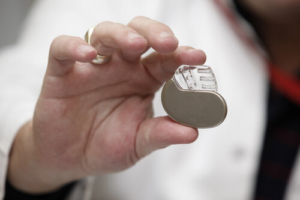Managing Eliquis side effects is crucial for patients prescribed this anticoagulant medication. By understanding its purpose, potential side effects, and necessary precautions, you can take control of your health and ensure the best possible outcomes. This comprehensive guide will walk you through everything you need to know about managing Eliquis side effects.
Key Takeaways
Eliquis is a prescription medication used to reduce the risk of stroke and blood clots, Side effects such as minor bleeding and bruising can occur.
Certain medical conditions, age and dosage may increase the risk of Eliquis side effects.
It is essential to be aware of potential risks associated with taking Eliquis and manage any minor bleeding or bruising through direct pressure or special bandages/dressings.
Understanding Eliquis and Its Purpose
Eliquis is a potent anticoagulant medication prescribed to prevent blood clots and reduce the risk of stroke in patients with atrial fibrillation or AFib. Eliquis (apixaban) was first approved by the US Food and Drug Administration (FDA) on December 28, 2012. It is also used for the prevention and treatment of deep venous thromboembolism. Its active ingredient, apixaban, works as a blood thinner by inhibiting factor Xa, a key protein component in the blood clotting process. Determining the right dosage of Eliquis involves considering many factors connected to the patient, including medical condition, age, weight, kidney function, response to treatment and current medications. All these aspects need to be taken into account for accurate dosage.
Benefits and Efficacy of Eliquis
Eliquis, also known by its active ingredient apixaban, is an anticoagulant medication that has been proven effective in reducing the risk of stroke in patients with atrial fibrillation. It works by inhibiting factor Xa, a crucial component in the blood clotting process, thus preventing the formation of harmful blood clots.
Before starting Eliquis treatment, consult your doctor about possible side effects. Although they are often mild, some patients might encounter serious side effects like internal bleeding. Awareness of these side effects is key to ensuring your safety while on this medication.
Common Side Effects of Eliquis
There are several common side effects of Eliquis which include:
Minor bleeding
Bruising
Nosebleeds
Dizziness
Headaches
Nausea
Fatigue
Potential for major bleeding
For example, minor bleeding associated with Eliquis may include nosebleeds, especially when taken with nonsteroidal anti-inflammatory drugs (NSAIDs). Bruising is another common side effect of Eliquis identified in several clinical studies.
While bleeding or bruising is a common side effect of Eliquis, the medication can also cause other non-bleeding side effects. These may include dizziness, headaches, nausea, and fatigue. Dizziness in particular can be a concern, as it may affect balance and coordination, potentially leading to falls or accidents.
If you experience persistent or severe non-bleeding side effects while taking Eliquis, it’s important to consult your healthcare provider. They can provide guidance on managing these side effects and decide whether a dosage adjustment or a switch to a different medication might be necessary.
Potential Serious Eliquis Side Effects
While most side effects of Eliquis are mild, there are some serious side effects to watch out for. These include:
Severe allergic reactions
Major bleeding
Abnormal bleeding at surgical sites
Complications related to spinal puncture or procedure
Mild to serious allergic reactions to Eliquis may include itching, hives, swelling of the face, lips, tongue, or throat, difficulty breathing, chest tightness, chest pain, and dizziness.
In case of severe symptoms of an allergic reaction or suspicion of a blood clot, immediately dial 911 or your local emergency number. Furthermore, should you experience mild symptoms, reach out to your doctor without delay. They can provide guidance on how to alleviate the symptoms and decide whether you should continue taking Eliquis.
Rates of Major Bleeding on Eliquis from Clinical Trials
Several major clinical trials have provided insights into the rates of major bleeding associated with Eliquis use. According to the ARISTOTLE trial, the annual rate of major bleeding was 2.13% among Eliquis users. The AVERROES trial reported a similar rate of 1.41%. The RE-LY trial, which compared Eliquis with warfarin, showed a major bleeding rate of 3.11% for patients on Eliquis. It’s important to note that these rates can vary depending on the patient’s overall health, other medications they are taking, and their dosage of Eliquis. For more detailed information, please refer to the original studies: ARISTOTLE trial, AVERROES trial, and RE-LY trial.
Interaction of Eliquis with NSAIDs, Aspirin, and Other Antiplatelets
Combining Eliquis with other medications that affect blood clotting, such as nonsteroidal anti-inflammatory drugs (NSAIDs), aspirin, or other antiplatelet drugs, can significantly increase the risk of bleeding side effects. These drugs, like Eliquis, inhibit the body’s ability to form clots, and using them in conjunction can intensify this effect, potentially leading to excessive bleeding. This can manifest in various ways, including prolonged bleeding from cuts, increased bruising, or more serious internal bleeding. It’s essential to discuss all medications and supplements you are taking with your healthcare provider to avoid harmful drug interactions while on Eliquis. Always check with your doctor if needed to take multiple blood thinning medications.
Medications and Supplements Affecting Eliquis Clearance
Certain medications and supplements can significantly impact the clearance of Eliquis from the body, potentially affecting its efficacy and increasing risk for side effects. Examples of medications that interfere with the metabolism of Eliquis include certain antifungals (such as itraconazole, ketoconazole), conivaptan, HIV medications (such as lopinavir, rifabutin, or ritonavir), St. John’s wort, drugs used to treat seizures (such as carbamazepine, phenytoin), to name a few.
Another supplement example, CBD (Cannabidiol), a popular supplement derived from cannabis, may interact with Eliquis. CBD has been shown to inhibit the cytochrome P450 system in the liver, a system that is crucial for the metabolism and clearance of Eliquis. This could potentially lead to an increased concentration of Eliquis in the body, heightening the risk of bleeding. Always consult your healthcare professional before starting any new medication or supplement while taking Eliquis to ensure safe and effective treatment.
Precautions and Warnings When Taking Eliquis
The FDA has issued warnings for Eliquis regarding potential risks of developing blood clots, including epidural blood clots, during certain spinal procedures. These warnings emphasize the importance of being aware of the potential risks associated with taking Eliquis, especially when undergoing spinal procedures or if treatment is discontinued prematurely.
To ensure the safe use of Eliquis, provide your doctor with your medical history and any other medications you are taking. Patients on Eliquis may experience bleeding near the spinal cord following certain spinal procedures, which can lead to long-term or permanent paralysis. Discuss the advantages and disadvantages of any procedure with your doctor before undergoing spinal procedures if you take Eliquis.
Is There a Reversal Agent or Antidote for Eliquis?
Andexanet alfa (Andexxa) is the first FDA approved medicine that reverses the effects of Eliquis in patients experiencing life-threatening or uncontrolled bleeding. It was approved in May 2018.
This medication is given through an IV and can only be given in a hospital setting.
Andexxa works by binding to the Eliquis in your system and preventing it from acting in your body. Your body’s natural clot forming process returns because the Eliquis is no longer stopping the factor Xa enzymes. It starts working within about 2 minutes and one dose will last for about 2 hours.
The ANNEXA-4 study found that Andexxa was able to decrease the blood thinning ability of Eliquis by 92%.
This could be life-saving in an emergency, but just know that when your normal clotting ability returns, so does your increased risk of a stroke due to AFib. You will need to be very carefully monitored by your doctor. In addition, Andexxa is expensive and may not be universally available in every hospital at the time of this writing.
Managing Minor Bleeding and Bruising
To maintain your comfort and well-being, it’s necessary to manage minor bleeding and bruising caused by Eliquis. To address minor bleeding, you can:
Apply direct pressure by holding a clean cloth or dressing over the bleeding area for about 10 minutes.
Utilize special bandages or wound dressings, such as BloodStop® and QuickClot® clotting sponge.
Use over-the-counter powders that are effective in halting bleeding in patients on blood thinners.
If the bleeding persists or becomes more intense, it is advisable to seek medical assistance, as it may be a medical emergency. Promptly addressing minor bleeding and bruising will help ensure your safety and comfort while taking Eliquis.

Alcohol Consumption and Eliquis
There is no direct interaction between Eliquis and alcohol. However, excessive alcohol consumption may heighten the risk of bleeding. Balancing responsible alcohol consumption and minimizing the risk of Eliquis associated side effects is important.
Consult with your doctor regarding safe alcohol consumption levels while taking Eliquis. By following their guidance, you can enjoy a healthy lifestyle while effectively managing your risk of blood clots and other complications related to Eliquis treatment.
Navigating Pregnancy and Breastfeeding on Eliquis
Eliquis is not advised during pregnancy or breastfeeding due to potential risks to both mother and baby. Pregnant women are particularly susceptible to complications related to blood clotting, and blood thinners like Eliquis are sometimes prescribed to reduce these risks. However, there is limited data available regarding the safety of Eliquis during pregnancy.
If you are pregnant or breastfeeding while taking Eliquis, consult your doctor to discuss alternative treatment options, as breast milk can also be affected. They can help you make informed decisions about your treatment plan to ensure the best possible outcome for both you and your baby.
Stopping Eliquis Safely: What You Need to Know
Eliquis should not be discontinued abruptly as it could increase the risk of both blood clots and stroke. Before discontinuing Eliquis, consulting your doctor to ensure a safe transition off the medication is vital. After ceasing Eliquis, blood clotting returns to pre-Eliquis levels within a few days, and the effects of Eliquis on blood clotting start to diminish within 24 hours of discontinuing treatment.
Always follow your doctor’s guidance when stopping Eliquis to minimize the risk of complications such as:
blood clots
heart attack
stroke
pulmonary embolism
deep vein thrombosis
Your healthcare professional can provide personalized advice based on your specific situation and medical history, including recommendations for knee replacement surgery if necessary.
Transitioning from Eliquis to Other Anticoagulants
Switching from Eliquis to another anticoagulant, such as warfarin or Xarelto, should be done under the guidance of your doctor to minimize the risk of blood clots and other complications. The precise instructions for transitioning from Eliquis to other anticoagulants may differ depending on the medication, but typically, it is suggested to discontinue Eliquis and initiate the new medication a few days later. Following your healthcare provider’s instructions is necessary for a successful transition and preserving your overall health and well-being.
Summary
In conclusion, understanding and managing Eliquis side effects is crucial for patients using this anticoagulant medication. By staying informed about potential side effects, necessary precautions, and how to safely transition from Eliquis to other anticoagulants, you can take control of your health and ensure the best possible outcomes. Remember, always consult your healthcare professional for personalized advice and guidance while taking Eliquis.
Frequently Asked Questions
What are the dangers of taking Eliquis?
Eliquis is a blood thinner, and can potentially lead to serious bleeding including internal organs such as the kidneys. It may also cause reactions like hives, swelling, joint pain or heavy vaginal bleeding. If you experience any of these side effects, contact your healthcare provider immediately.
What should you avoid while taking Eliquis?
To avoid serious side effects while taking Eliquis, it is important to refrain from drinking alcohol and consuming grapefruit or any of its products. People with cardiovascular issues should also limit their consumption of coffee and foods heavy in fat.
Does Eliquis affect your legs?
Eliquis is not expected to cause joint pain or leg weakness. However, having certain spinal procedures while taking Eliquis may increase the risk of blood clots in the spine, which can lead to numbness or weakness in the legs.
What happens when you stop taking Eliquis?
If you stop taking Eliquis earlier than recommended by your doctor, your risk of developing dangerous blood clots and having a stroke is increased.
How long does Eliquis stay in your system after stopping?
Eliquis typically stays in your system for approximately 48 hours after the last dose. However, this can vary depending on individual factors such as your age, kidney function, and overall health. Always consult your healthcare provider for personalized advice.
Are there certain foods you should avoid while on Eliquis?
Yes, while on Eliquis, avoid grapefruit, grapefruit juice, marmalades, limes, and pomelos, as they can increase the level of Eliquis in your blood, heightening the risk of side effects. Always consult your healthcare provider for personalized dietary advice while on Eliquis.
Does Eliquis cause stomach problems?
While stomach problems are not a common side effect of Eliquis, some patients may experience gastrointestinal issues such as nausea, constipation, or upset stomach. If these symptoms persist or become severe, it’s important to consult your healthcare provider for guidance.
Does Eliquis hurt your kidneys?
Eliquis itself does not typically damage the kidneys. However, if a patient has pre-existing kidney problems, the medication could increase risk of bleeding if the correct doseage is not prescribed. This is because Eliquis is partially cleared by the kidneys, and impaired kidney function could lead to higher levels of the medication in the bloodstream, potentially increasing the risk of bleeding. Therefore, it’s important for patients with kidney issues to have their kidney function regularly monitored while taking Eliquis, and the dosage may need to be adjusted accordingly. As always, any concerns should be discussed with a healthcare provider.
Does Eliquis cause hair loss?
Hair loss is not a commonly reported side effect of Eliquis. However, there have been cases reported of hair loss due to blood thinners, individual reactions to medications can vary, and if you notice unusual hair loss while taking Eliquis, it’s important to discuss this with your healthcare provider. They can help determine whether the hair loss is related to your medication, or if there may be other underlying causes.
The Best Atrial Fibrillation Book
Your Complete Guide To AFib: The Essential Manual For Every Patient With Atrial Fibrillation
$15.95 (as of April 28, 2024 10:33 GMT -06:00 - More infoProduct prices and availability are accurate as of the date/time indicated and are subject to change. Any price and availability information displayed on [relevant Amazon Site(s), as applicable] at the time of purchase will apply to the purchase of this product.) The A to Z guide on everything you need to know about atrial fibrillation. Written by AFib expert Dr. Percy Morales MD. Over 120 pages of essential information on medications, procedures, and lifestyles modifications for AFib. Easy to read for every patient.
Shop AFib Products on Amazon
KardiaMobile 6-Lead Personal EKG Monitor – Six Views of The Heart – Detects AFib and Irregular Arrhythmias – Instant Results in 30 Seconds – Works with Most Smartphones - FSA/HSA Eligible

KardiaMobile 1-Lead Personal EKG Monitor – Record EKGs at Home – Detects AFib and Irregular Arrhythmias – Instant Results in 30 Seconds – Easy to Use – Works with Most Smartphones - FSA/HSA Eligible

Apple Watch Series 9 [GPS 41mm] Smartwatch with Storm Blue Aluminum Case with Silver Sport Band M/L. Fitness Tracker, Blood Oxygen & ECG Apps, Always-On Retina Display

Fitbit Sense 2 Advanced Health and Fitness Smartwatch with Tools to Manage Stress and Sleep, ECG App, SpO2, 24/7 Heart Rate and GPS, Shadow Grey/Graphite, One Size (S & L Bands Included)

OMRON - Complete Wireless Upper Arm Blood Pressure Monitor + EKG - Built-in Bluetooth Technology

Omron Hem 7361T Bluetooth Digital Blood Pressure Monitor with Afib Indicator and 360° Accuracy Intelliwrap Cuff for Most Accurate Measurements (White)

EMAY Portable ECG Monitor | Record ECG and Heart Rate Anytime Anywhere | Stand-Alone Device with LCD Screen and Storage | No Subscription Required

Samsung Galaxy Watch 6 44mm Smartwatch with HR Zones, Sleep Coaching, Heart Monitor - Graphite

Natural Rhythm Triple Calm Magnesium 150 mg - 120 Capsules – Magnesium Complex Compound Supplement with Magnesium Glycinate, Malate, and Taurate. Calming Blend for Promoting Rest and Relaxation.

Pure Encapsulations Magnesium (Glycinate) - Supplement to Support Stress Relief, Sleep, Heart Health, Nerves, Muscles, and Metabolism* - with Magnesium Glycinate - 180 Capsules


















![Apple Watch Series 9 [GPS 41mm] Smartwatch with Storm Blue Aluminum Case with Silver Sport Band M/L. Fitness Tracker, Blood Oxygen & ECG Apps, Always-On Retina Display #1](https://m.media-amazon.com/images/I/311xwtp4mFL._SL100_.jpg)
![Apple Watch Series 9 [GPS 41mm] Smartwatch with Storm Blue Aluminum Case with Silver Sport Band M/L. Fitness Tracker, Blood Oxygen & ECG Apps, Always-On Retina Display #2](https://m.media-amazon.com/images/I/41j+8AaUGsL._SL100_.jpg)
![Apple Watch Series 9 [GPS 41mm] Smartwatch with Storm Blue Aluminum Case with Silver Sport Band M/L. Fitness Tracker, Blood Oxygen & ECG Apps, Always-On Retina Display #3](https://m.media-amazon.com/images/I/41jIyxZitnL._SL100_.jpg)
![Apple Watch Series 9 [GPS 41mm] Smartwatch with Storm Blue Aluminum Case with Silver Sport Band M/L. Fitness Tracker, Blood Oxygen & ECG Apps, Always-On Retina Display #4](https://m.media-amazon.com/images/I/41IpNJERjCL._SL100_.jpg)
![Apple Watch Series 9 [GPS 41mm] Smartwatch with Storm Blue Aluminum Case with Silver Sport Band M/L. Fitness Tracker, Blood Oxygen & ECG Apps, Always-On Retina Display #5](https://m.media-amazon.com/images/I/31o17yhfYpL._SL100_.jpg)

















































